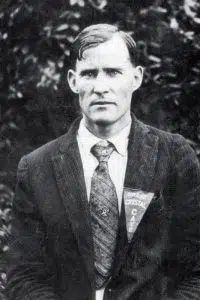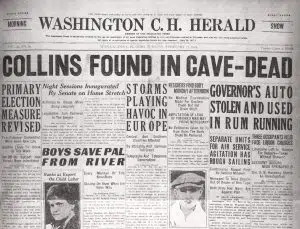BY JENNIFER MOONSONG
GLASGOW NEWS 1
PHOTOS PROVIDED BY THE NATIONAL PARK SERVICE
It was 98 years ago this month that legendary Kentucky cave explorer Floyd Collins made news that Kentuckians and spelunkers still talk about today.

Floyd Collins was only 37 when he died, but he has lived on in history for nearly 100 years.
Collins was a pioneer of cave exploration, and the Collins family owned Crystal Cave and lesser-known portions of Mammoth Cave. It was a goal of Collins’ to link the two caves through his explorations. On Jan. 30, 1925, while pursuing such, he became trapped in a narrow passageway approximately 150 feet from the entrance.
Although Collins was found the next day and supplied with food, rescue efforts dragged on too long. On Feb. 17, rescuers found him dead. He had been dead for only a few days. Deciding the risk was far too great to excavate the body, Floyd Collins was left in the cave, where he was covered with debris. A funeral of sorts was held at the mouth of the cave. The place of his death became known as Sand Cave in the media, and a media frenzy did ensue because of a journalist known at “Skeets.”
William Burke “Skeets” Miller worked for the Courier-Journal and obsessively covered the life, death, and attempted rescue of Collins, earning himself a 1926 Pulitzer Prize for Reporting. Thanks to the telegraph and the world’s newest media of the day, broadcast radio, the news travel far and wide, giving Collins a permanent place in history books.

Newspapers and radio stations across the country spread the news of Floyd Collins’ entrapment and death.
The rescue became one of the biggest national media events of its time.
Although it was the place of his death and makeshift grave, those who came were not somber. Many accounts of the events following his death describe it as a carnival style atmosphere, with trinkets and treats being sold. Thousands visited the cave. Opportunists of all sorts made money and gained attention from the death. On April 23, 1925, Floyd’s brother Homer and friends opened the shaft, dug another tunnel and successful recovered Floyd Collins’ body.
Two days later, he was buried near Great Crystal Cave on the family farm. One might think that is the end of the saga of Floyd Collins, but it was not.
When the family farm sold, the new owner decided to exhume the body of Collins, place it in glass-topped coffin, and the corpse was displayed in Crystal Cave for years. The Collins family was not pleased with the spectacle. Again, one might think that was the end of the story, but it was not.
On the night of March 18, 1929, the remains of Floyd Collins were stolen from the coffin and were found in a nearby field with a missing left leg. What was left of Floyd was moved deep inside Crystal Cave, and the coffin was chained to prevent further incident.
In 1961, Mammoth Cave National Park purchased the property and, at last, Collins was given a proper burial. What was left of him was buried at the Mammoth Cave Baptist Church Cemetery. Although Collins was little known in life, he rose to fame posthumously. A musical, a documentary film and numerous books documented his tragic death. On his tombstone the following words are engraved: “The greatest cave explorer ever known.”
–Information for this report was gathered from local history publications.
Comments